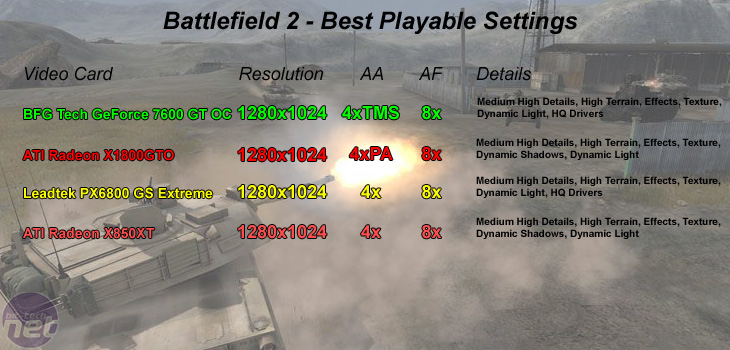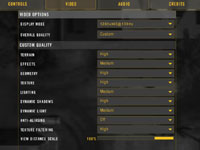Battlefield 2
Publisher: Electronic ArtsBattlefield 2 features an all-new game engine based on the DirectX 9.0 API. There is no Shader Model 3.0 support, but the majority of hardware will use a Shader Model 2.0++ mode that includes support for Normal Maps, Parallax Mapping, Full-Resolution Dynamic Shadowing, Post Processing and Fog.
The game will look the same on both NVIDIA and ATI hardware, so there is no advantage of choosing one over the other in image quality related circumstances. The only major difference is that Ultra Shadow 2 is utilised on NVIDIA's hardware, while the shadowing on ATI hardware is done using a slightly different technique.
We patched the game to version 1.2 and then played three five-minute segments of the 'Strike at Karkand' map, reporting the median frame rate. We found that there was no ready way to duplicate testing situations manually in this game, so we felt that taking a typical slice of action from the game was the best way to report our findings. We controlled Anti-Aliasing from inside the game, while Anisotropic Filtering was set to 8xAF when the 'Texture Filtering' option was set to 'High'.


Both cards were playable with 4xAA 8xAF along with their respective multisampled transparency antialiasing modes enabled too. This gave a pretty good gaming experience on the whole. Along with the higher image quality, the Radeon X1800GTO also had a frame rate advantage, meaning that the experience was a smoother one.
The Radeon X850XT and Leadtek GeForce 6800 GS Extreme were both slower than the two newcomers and neither were able to utilise transparency antialiasing, either. The Radeon X850XT was able to play at a slightly higher detail level and delivered a higher average frame rate than the Leadtek. However, the Leadtek PX6800 GS Extreme had a distinct advantage in the minimum frame rate department.

MSI MPG Velox 100R Chassis Review
October 14 2021 | 15:04







Want to comment? Please log in.